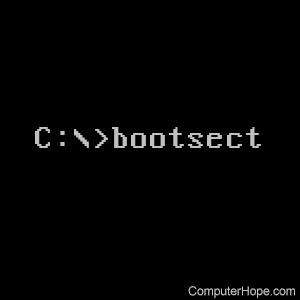Bootsect command
Updated: 11/12/2023 by Computer Hope

The bootsect command updates the master boot code for hard disk partitions to switch between BOOTMGR and NTLDR. Use the tool to restore the boot sector on your computer and it can be used for FAT and NTFS based file systems, replacing the FixFAT and FixNTFS tools.
Availability
Bootsect command is an external command available for the following versions of Microsoft operating systems as bootsec.exe.
Bootsect syntax
bootsect {/help|/nt60|/nt52} {SYS|ALL|<DriveLetter>:} [/force] [/mbr]
| Drive: | The drive letter to be searched. |
|---|---|
| /help | Displays these usage instructions. |
| /nt52 | Applies the master boot code that is compatible with NTLDR to SYS, ALL, or <DriveLetter>. The operating system installed on SYS, ALL, or <DriveLetter> must be older than Windows Vista. |
| /nt60 | Applies the master boot code that is compatible with BOOTMGR to SYS, ALL, or <DriveLetter>. The operating system installed on SYS, ALL, or <DriveLetter> must be Windows Vista, Windows Server 2008 or later. |
| SYS | Updates the master boot code on the system partition used to boot Windows. |
| ALL | Updates the master boot code on all partitions. ALL does not necessarily update the boot code for each volume. Instead, this option updates the boot code on volumes that could be used as Windows boot volumes, which excludes any dynamic volumes not connected with an underlying disk partition. This restriction is present because boot code must be located at the beginning of a disk partition. |
| <DriveLetter> | Updates the master boot code on the volume associated with this drive letter. Boot code is not updated if either 1) <DriveLetter> is not associated with a volume or 2) <DriveLetter> is associated with a volume not connected to an underlying disk partition. |
| /force | Forcibly dismounts the volume(s) during the boot code update. You should use this option with caution. If Bootsect.exe cannot gain exclusive volume access, the file system may overwrite the boot code before the next reboot. Bootsect.exe always attempts to lock and dismount the volume before each update. When /force is specified, a forced dismount is attempted if the initial lock attempt fails. A lock can fail, for example, if files on the target volume are currently opened by other programs. When successful, a forced dismount allows exclusive volume access and a reliable boot code update even though the initial lock failed. At the same time, a forced dismount invalidates all open handles to files on the target volume resulting in unexpected behavior from the programs that opened these files. Therefore, use this option with caution. |
| /mbr | Updates the master boot record without changing the partition table on sector 0 of the disk containing the partition specified by SYS, ALL, or drive letter. When used with /nt52 option, the master boot record is compatible with operating systems older than Windows Vista. When used with the /nt60 option, the master boot record is compatible with Windows Vista, Windows Server 2008 or later. |
Bootsect examples
To apply the master boot code that is compatible with NTLDR to the volume labeled E:, use the following command:
bootsect /nt52 E:
